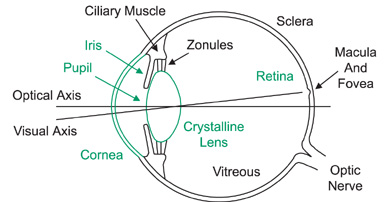Optipedia • SPIE Press books opened for your reference.
Explanation of Eye from Field Guide to Geometrical Optics
Excerpt from Field Guide to Geometrical Optics

Right Eye
Horizontal Section
The optical power of the human eye is about 60 D, of which the cornea provides 43 D. The base radius of curvature of the cornea is about 8 mm, and the overall length of the eye is about 25 mm. Since the vitreous (nV = 1.337) fills the eye, the rear focal length differs from the focal length.

Anatomical variations between eyes can be as much as 25%. The crystalline lens is a gradient index element; it has a higher index at its center. The relaxed power of the lens is about 19 D, and the eye focuses at infinity. To view near objects, the ciliary muscle contracts, causing the lens powerto increase. The lens bulges and its radii of curvature become steeper. The range of accommodation varies with age, but can be as much as 15 D. The iris is the stop of the eye. The pupil is the EP of the eye and has a typical diameter of about 4 mm, with a range of 2–8 mm.
The front and rear principal planes of the eye P and P′ are located about 1.6 mm and 1.9 mm, respectively, behind the vertex of the cornea. The system nodal points N and N′ are located near the anterior surface of the lens, 7.2 mm and 7.5 mm, respectively, from the corneal vertex. The visual axis of the eye is defined by the macula and is displaced about 5° nasally from the optical axis.
J. E. Greivenkamp, Field Guide to Geometrical Optics, SPIE Press, Bellingham, WA (2004).
View SPIE terms of use.

